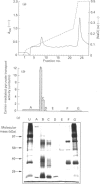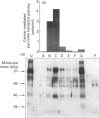Abstract
1. Intact erythrocytes were incubated with 100 microM-4,4'-di-isothiocyanostilbene-2,2'-disulphonate (DIDS), a concentration sufficient to inhibit lactate transport irreversibly by 65%. DIDS-labelled proteins were detected by immunoblotting of erythrocyte membrane proteins with an anti-DIDS antibody. Labelled polypeptides of 35-45 kDa in rat erythrocytes, and of 40-50 kDa in rabbit and guinea pig erythrocytes, were detected by this technique. In human erythrocytes, which have 10-fold less transport activity, no labelled polypeptide in this molecular mass range was detected. 2. Labelling of these 35-50 kDa polypeptides was decreased markedly in the presence of the specific inhibitors of lactate transport alpha-cyano-4-hydroxycinnamate and 4,4'-dibenzamidostilbene-2,2'-disulphonate (DBDS), which compete with DIDS for binding to the transporter. However, the weakly bound inhibitor 4,4'-dinitrostilbene-2,2'-disulphonate (DNDS) afforded little protection against labelling by DIDS. 3. The lactate transporter from rat erythrocytes was solubilized with decanoyl-N-methyl glucamide (MEGA-10) and partially purified by Mono-Q anion-exchange chromatography, with transport activity eluting at 0.1-0.15 M-NaCl. The 35-45 kDa DIDS-labelled polypeptide from rat erythrocytes was eluted in the same peak of protein as lactate transporter activity during Mono-Q chromatography. 4. These observations provide strong evidence that the lactate transporter is a polypeptide of 35-45 kDa in rat erythrocytes and of 40-50 kDa in rabbit and guinea pig erythrocytes.
Full text
PDF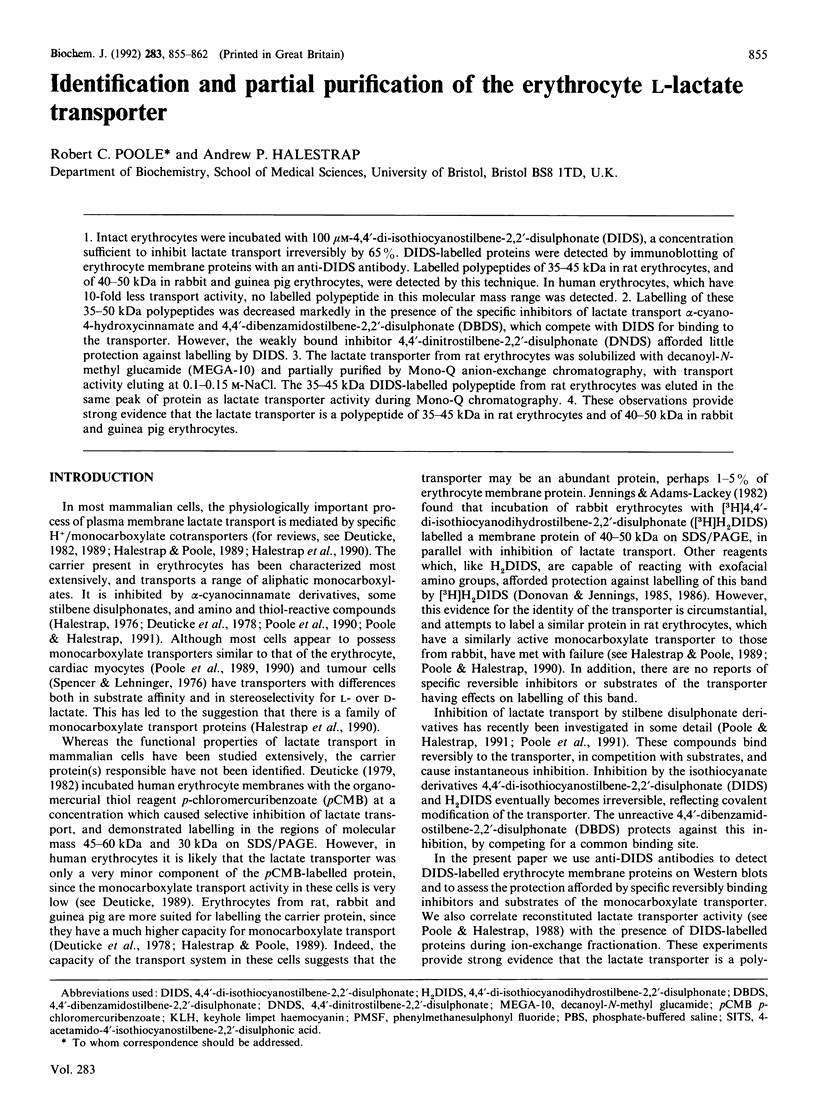
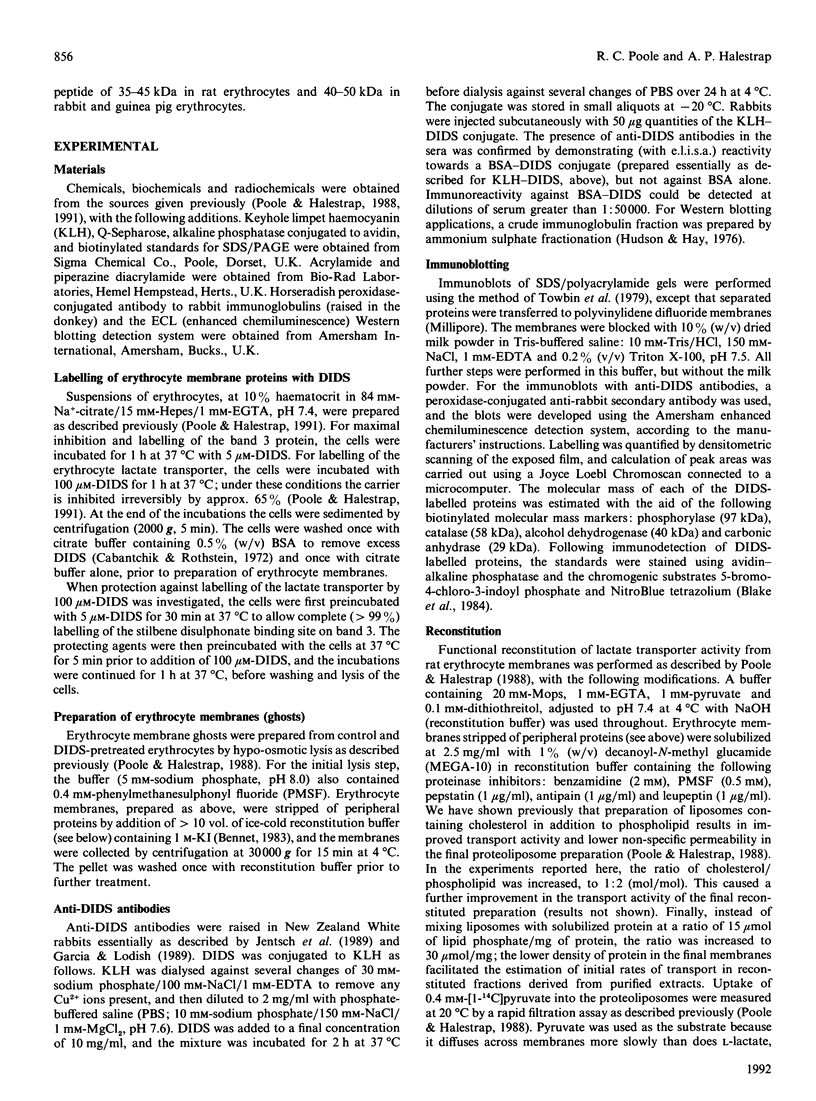

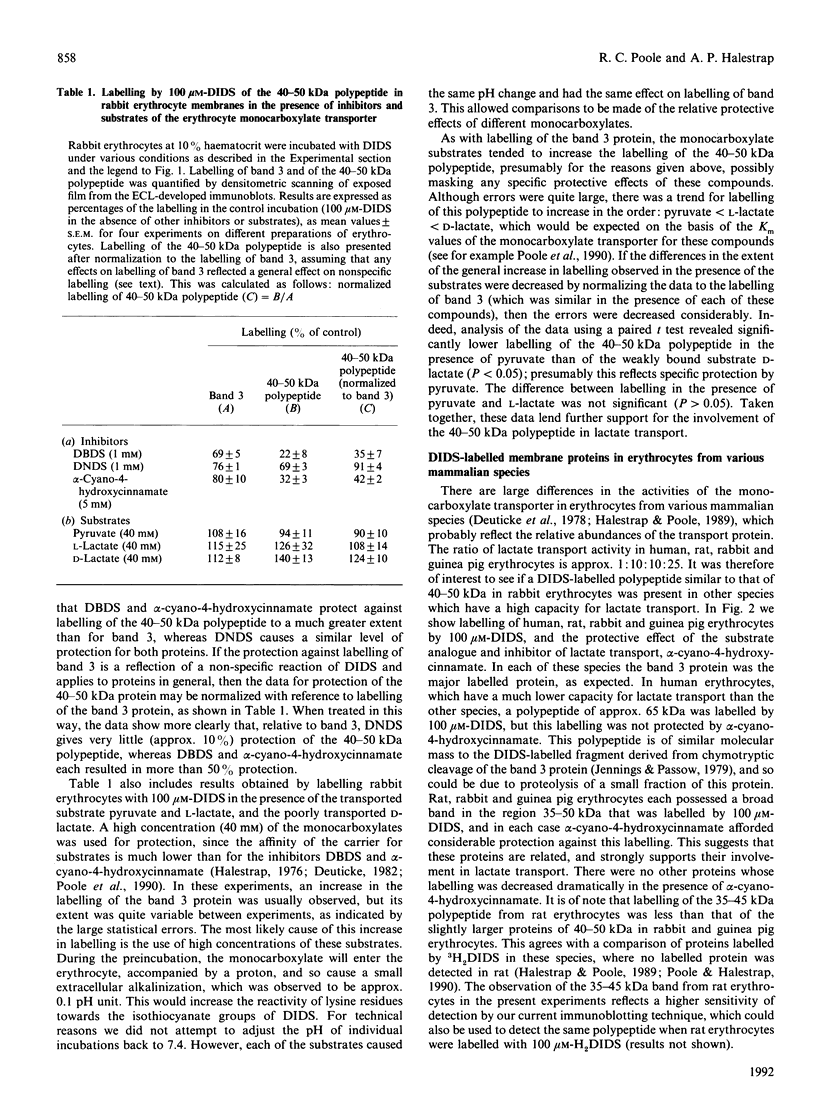
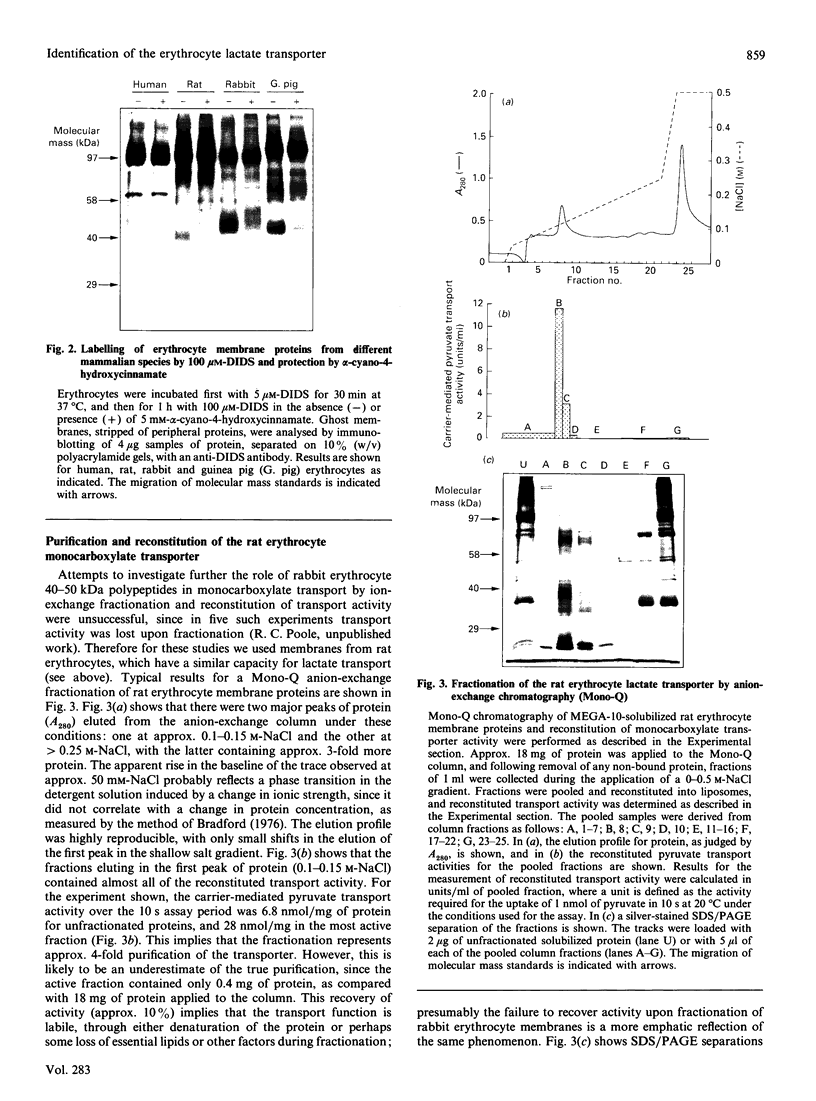
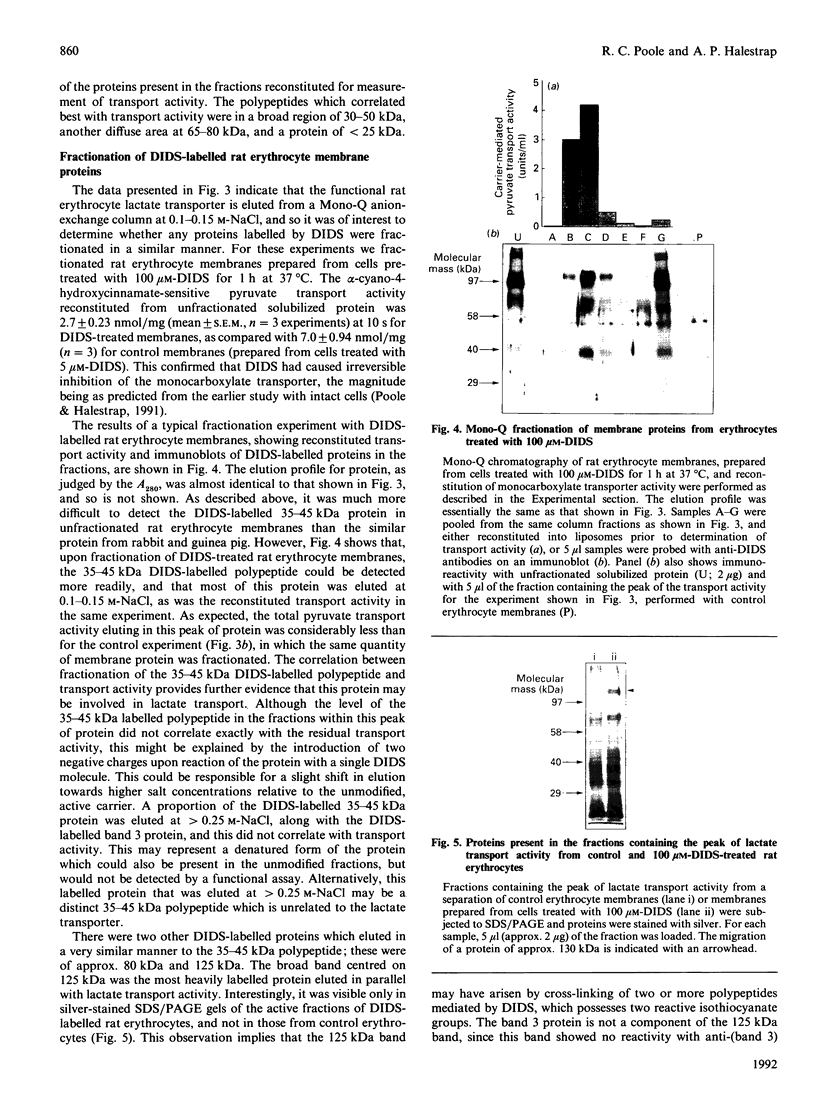
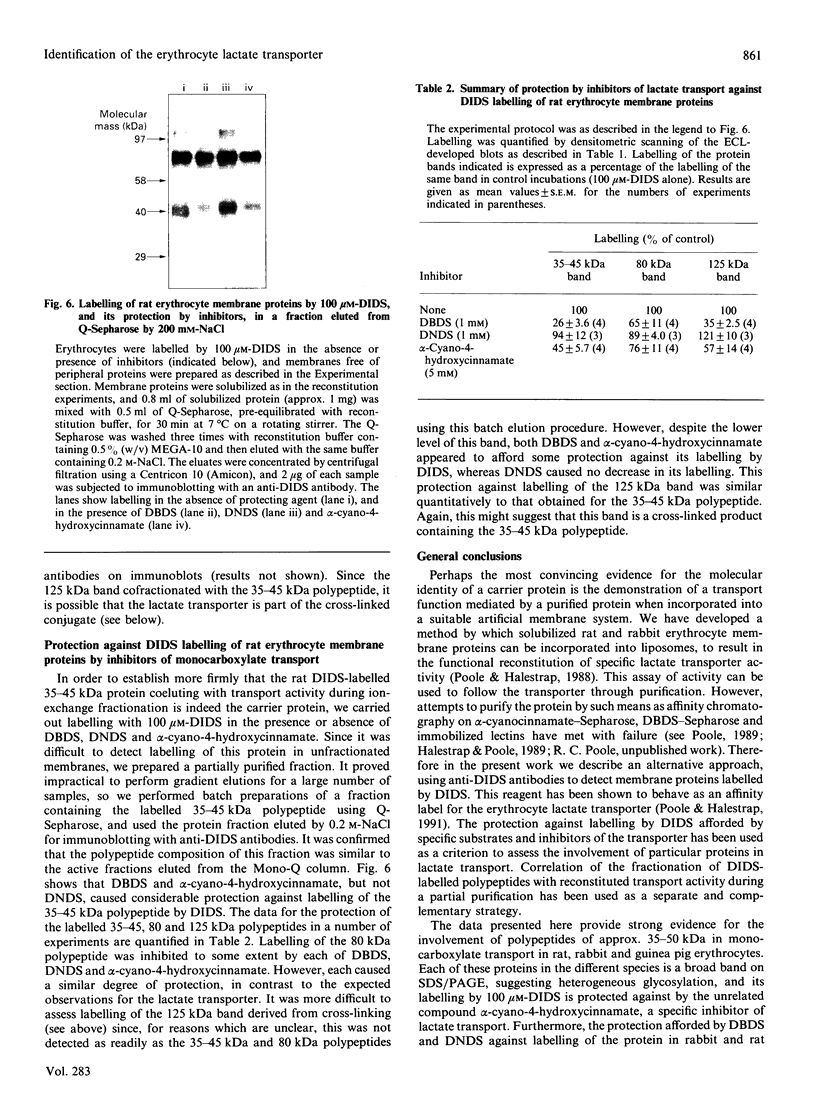
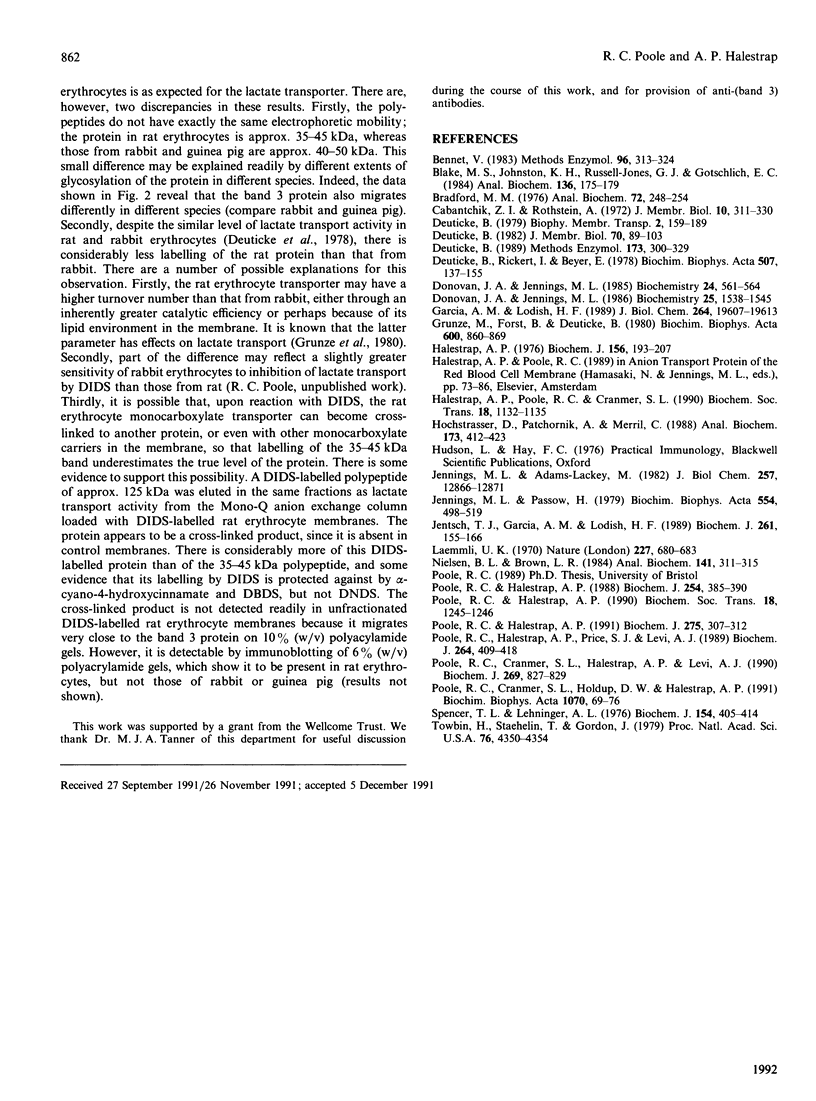
Images in this article
Selected References
These references are in PubMed. This may not be the complete list of references from this article.
- Bennett V. Proteins involved in membrane--cytoskeleton association in human erythrocytes: spectrin, ankyrin, and band 3. Methods Enzymol. 1983;96:313–324. doi: 10.1016/s0076-6879(83)96029-9. [DOI] [PubMed] [Google Scholar]
- Blake M. S., Johnston K. H., Russell-Jones G. J., Gotschlich E. C. A rapid, sensitive method for detection of alkaline phosphatase-conjugated anti-antibody on Western blots. Anal Biochem. 1984 Jan;136(1):175–179. doi: 10.1016/0003-2697(84)90320-8. [DOI] [PubMed] [Google Scholar]
- Bradford M. M. A rapid and sensitive method for the quantitation of microgram quantities of protein utilizing the principle of protein-dye binding. Anal Biochem. 1976 May 7;72:248–254. doi: 10.1016/0003-2697(76)90527-3. [DOI] [PubMed] [Google Scholar]
- Cabantchik Z. I., Rothstein A. The nature of the membrane sites controlling anion permeability of human red blood cells as determined by studies with disulfonic stilbene derivatives. J Membr Biol. 1972 Dec 29;10(3):311–330. doi: 10.1007/BF01867863. [DOI] [PubMed] [Google Scholar]
- Deuticke B. Monocarboxylate transport in erythrocytes. J Membr Biol. 1982;70(2):89–103. doi: 10.1007/BF01870219. [DOI] [PubMed] [Google Scholar]
- Deuticke B. Monocarboxylate transport in red blood cells: kinetics and chemical modification. Methods Enzymol. 1989;173:300–329. doi: 10.1016/s0076-6879(89)73020-2. [DOI] [PubMed] [Google Scholar]
- Deuticke B., Rickert I., Beyer E. Stereoselective, SH-dependent transfer of lactate in mammalian erythrocytes. Biochim Biophys Acta. 1978 Feb 2;507(1):137–155. doi: 10.1016/0005-2736(78)90381-4. [DOI] [PubMed] [Google Scholar]
- Donovan J. A., Jennings M. L. Membrane polypeptide in rabbit erythrocytes associated with the inhibition of L-lactate transport by a synthetic anhydride of lactic acid. Biochemistry. 1985 Jan 29;24(3):561–564. doi: 10.1021/bi00324a003. [DOI] [PubMed] [Google Scholar]
- Donovan J. A., Jennings M. L. N-hydroxysulfosuccinimido active esters and the L-(+)-lactate transport protein in rabbit erythrocytes. Biochemistry. 1986 Apr 8;25(7):1538–1545. doi: 10.1021/bi00355a012. [DOI] [PubMed] [Google Scholar]
- Garcia A. M., Lodish H. F. Lysine 539 of human band 3 is not essential for ion transport or inhibition by stilbene disulfonates. J Biol Chem. 1989 Nov 25;264(33):19607–19613. [PubMed] [Google Scholar]
- Grunze M., Forst B., Deuticke B. Dual effect of membrane cholesterol on simple and mediated transport processes in human erythrocytes. Biochim Biophys Acta. 1980 Aug 14;600(3):860–869. doi: 10.1016/0005-2736(80)90489-7. [DOI] [PubMed] [Google Scholar]
- Halestrap A. P., Poole R. C., Cranmer S. L. Mechanisms and regulation of lactate, pyruvate and ketone body transport across the plasma membrane of mammalian cells and their metabolic consequences. Biochem Soc Trans. 1990 Dec;18(6):1132–1135. doi: 10.1042/bst0181132. [DOI] [PubMed] [Google Scholar]
- Halestrap A. P. Transport of pyruvate nad lactate into human erythrocytes. Evidence for the involvement of the chloride carrier and a chloride-independent carrier. Biochem J. 1976 May 15;156(2):193–207. doi: 10.1042/bj1560193. [DOI] [PMC free article] [PubMed] [Google Scholar]
- Hochstrasser D. F., Patchornik A., Merril C. R. Development of polyacrylamide gels that improve the separation of proteins and their detection by silver staining. Anal Biochem. 1988 Sep;173(2):412–423. doi: 10.1016/0003-2697(88)90208-4. [DOI] [PubMed] [Google Scholar]
- Jennings M. L., Adams-Lackey M. A rabbit erythrocyte membrane protein associated with L-lactate transport. J Biol Chem. 1982 Nov 10;257(21):12866–12871. [PubMed] [Google Scholar]
- Jennings M. L., Passow H. Anion transport across the erythrocyte membrane, in situ proteolysis of band 3 protein, and cross-linking of proteolytic fragments by 4,4'-diisothiocyano dihydrostilbene-2,2'-disulfonate. Biochim Biophys Acta. 1979 Jul 5;554(2):498–519. doi: 10.1016/0005-2736(79)90387-0. [DOI] [PubMed] [Google Scholar]
- Jentsch T. J., Garcia A. M., Lodish H. F. Primary structure of a novel 4-acetamido-4'-isothiocyanostilbene-2,2'-disulphonic acid (SITS)-binding membrane protein highly expressed in Torpedo californica electroplax. Biochem J. 1989 Jul 1;261(1):155–166. doi: 10.1042/bj2610155. [DOI] [PMC free article] [PubMed] [Google Scholar]
- Laemmli U. K. Cleavage of structural proteins during the assembly of the head of bacteriophage T4. Nature. 1970 Aug 15;227(5259):680–685. doi: 10.1038/227680a0. [DOI] [PubMed] [Google Scholar]
- Nielsen B. L., Brown L. R. The basis for colored silver-protein complex formation in stained polyacrylamide gels. Anal Biochem. 1984 Sep;141(2):311–315. doi: 10.1016/0003-2697(84)90047-2. [DOI] [PubMed] [Google Scholar]
- Poole R. C., Cranmer S. L., Halestrap A. P., Levi A. J. Substrate and inhibitor specificity of monocarboxylate transport into heart cells and erythrocytes. Further evidence for the existence of two distinct carriers. Biochem J. 1990 Aug 1;269(3):827–829. doi: 10.1042/bj2690827. [DOI] [PMC free article] [PubMed] [Google Scholar]
- Poole R. C., Cranmer S. L., Holdup D. W., Halestrap A. P. Inhibition of L-lactate transport and band 3-mediated anion transport in erythrocytes by the novel stilbenedisulphonate N,N,N',N'-tetrabenzyl-4,4'-diaminostilbene-2,2'-disulpho nat e (TBenzDS). Biochim Biophys Acta. 1991 Nov 18;1070(1):69–76. doi: 10.1016/0005-2736(91)90147-z. [DOI] [PubMed] [Google Scholar]
- Poole R. C., Halestrap A. P. Inhibition and labelling of the erythrocyte lactate transporter by stilbene disulphonates. Biochem Soc Trans. 1990 Dec;18(6):1245–1246. doi: 10.1042/bst0181245. [DOI] [PubMed] [Google Scholar]
- Poole R. C., Halestrap A. P., Price S. J., Levi A. J. The kinetics of transport of lactate and pyruvate into isolated cardiac myocytes from guinea pig. Kinetic evidence for the presence of a carrier distinct from that in erythrocytes and hepatocytes. Biochem J. 1989 Dec 1;264(2):409–418. doi: 10.1042/bj2640409. [DOI] [PMC free article] [PubMed] [Google Scholar]
- Poole R. C., Halestrap A. P. Reconstitution of the L-lactate carrier from rat and rabbit erythrocyte plasma membranes. Biochem J. 1988 Sep 1;254(2):385–390. doi: 10.1042/bj2540385. [DOI] [PMC free article] [PubMed] [Google Scholar]
- Poole R. C., Halestrap A. P. Reversible and irreversible inhibition, by stilbenedisulphonates, of lactate transport into rat erythrocytes. Identification of some new high-affinity inhibitors. Biochem J. 1991 Apr 15;275(Pt 2):307–312. doi: 10.1042/bj2750307. [DOI] [PMC free article] [PubMed] [Google Scholar]
- Spencer T. L., Lehninger A. L. L-lactate transport in Ehrlich ascites-tumour cells. Biochem J. 1976 Feb 15;154(2):405–414. doi: 10.1042/bj1540405. [DOI] [PMC free article] [PubMed] [Google Scholar]
- Towbin H., Staehelin T., Gordon J. Electrophoretic transfer of proteins from polyacrylamide gels to nitrocellulose sheets: procedure and some applications. Proc Natl Acad Sci U S A. 1979 Sep;76(9):4350–4354. doi: 10.1073/pnas.76.9.4350. [DOI] [PMC free article] [PubMed] [Google Scholar]





